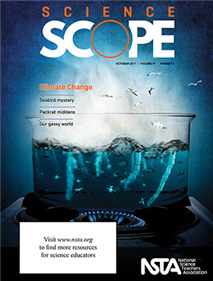All Science Scope resources
Journal Article
Using Packrat Midden Models to Investigate Climate Variability
Explore past climates with these unique natural archives....
Journal Article
The Seabird Mystery Lesson: Integrating Science Inquiry and Science Literacy
Can your students explain why auklets are dying?...
Journal Article
A Gassy World: A Climate Change Investigation
Will warming oceans be better or worse at absorbing CO2?...
Journal Article
This column shares how teachers use technology for assessment, student learning, or classroom management. This article describes a student-driven approach to learning and communicating about climate change, in which students create a short, document...
Journal Article
From the Editor's Desk: Tackling the Complex Issue of Climate Change
Science Scope’s editor shares thoughts regarding the current issue....
Journal Article
Citizen Science: Be a Bat Detective!
This column highlights formal and informal science research projects that students can join and contribute to by gathering and sharing data. Students classify bat calls by listening to short clips of sound recordings online....
Journal Article
Disequilibrium: Measuring Our Rising Sea Levels
This column shows how to use discrepant events to confront misconceptions. Does the melting Antarctica ice cause sea levels to rise more than melting Arctic ice? This month’s discrepant event answers this question....
Journal Article
Listserv Roundup: Growth Mindset in the Classroom
This column shares recent conversations taken from the NSTA listserv community about current science education topics. This month's column provides tips that can help teachers promote a community of growth mindset learners in the classroom....
Journal Article
Science For All: Self-Improvement Through Goal Setting
This column shares strategies for increasing student engagement. In September's column, the authors discussed the importance of grit and how you can help your students become grittier throughout the school year. In addition to the suggestions we gave...
Journal Article
Teacher to Teacher: Vote, Discuss, Revote: A Formative Assessment Classroom Technique
This column provides practical advice from your peers. Formative Assessment Classroom Techniques, or FACTS, allow teachers to assess student thinking. This article discusses the Vote-Discuss-Revote (VDR) FACT. VDR provides students with a question o...
Journal Article
Scope on the Skies: A Candle in Space
This column focuses on astronomy throughout the year. This month’s issue discusses the challenges of measuring distances to celestial objects....


